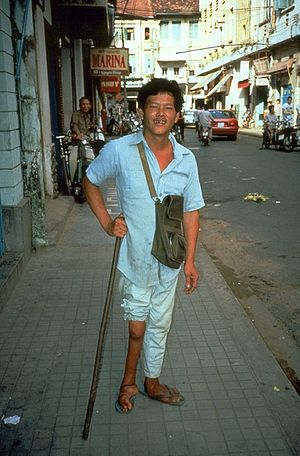Poliomyelitis
| Poliomyelitis | |
|---|---|
 |
|
| A man with a smaller right leg due to poliomyelitis | |
| Pronunciation | /ˌpoʊlioʊˌmaɪəˈlaɪtɪs/ |
| Classification and external resources | |
| Specialty | Neurology, infectious disease |
| ICD-10 | A80, B91, P35.8 |
| ICD-9-CM | 045, 138 |
| DiseasesDB | 10209 |
| MedlinePlus | 001402 |
| eMedicine | ped/1843 pmr/6 |
| MeSH | C02.182.600.700 |
Poliomyelitis, often called polio or infantile paralysis, is an infectious disease caused by the poliovirus. In about 0.5% of cases there is muscle weakness resulting in an inability to move. This can occur over a few hours to few days. The weakness most often involves the legs but may less commonly involve the muscles of the head, neck and diaphragm. Many but not all people fully recover. In those with muscle weakness about 2% to 5% of children and 15% to 30% of adults die. Another 25% of people have minor symptoms such as fever and a sore throat and up to 5% have headache, neck stiffness and pains in the arms and legs. These people are usually back to normal within one or two weeks. In up to 70% of infections there are no symptoms. Years after recovery post-polio syndrome may occur, with a slow development of muscle weakness similar to that which the person had during the initial infection.
Poliovirus is usually spread from person to person through infected fecal matter entering the mouth. It may also be spread by food or water containing human feces and less commonly from infected saliva. Those who are infected may spread the disease for up to six weeks even if no symptoms are present. The disease may be diagnosed by finding the virus in the feces or detecting antibodies against it in the blood. The disease only occurs naturally in humans.
The disease is preventable with the polio vaccine; however, a number of doses are required for it to be effective. The US Centers for Disease Control and Prevention recommends polio vaccination boosters for travelers and those who live in countries where the disease is occurring. Once infected there is no specific treatment. In 2016, polio affected 42 people, while there were about 350,000 cases in 1988. In 2014 the disease was only spreading between people in Afghanistan, Nigeria, and Pakistan. In 2015 Nigeria had stopped the spread of wild poliovirus but it reoccurred in 2016.
...
Wikipedia
